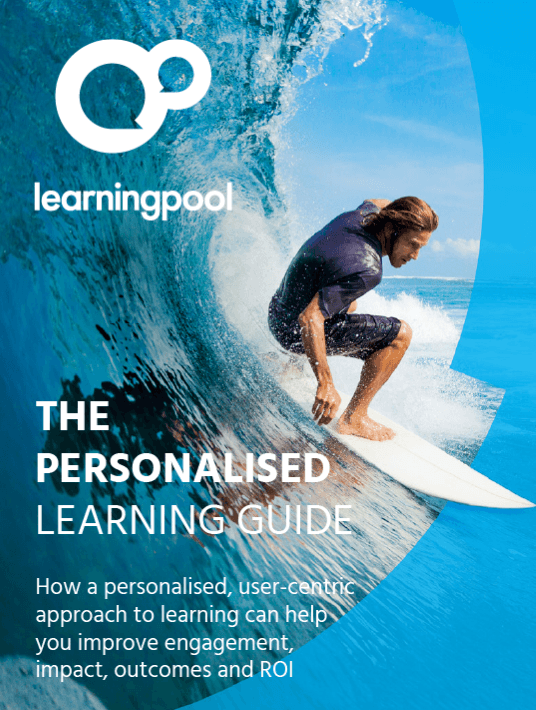Getting The Fullest From Your LXP With Personalised Learning Plans
We’re used to training that sets out a series of learning objectives. 'After this lesson, you will be able to, etc.' Or 'you have learned how to, etc.' These can help manage learner and instructor expectations and ensure alignment with an organisation’s L&D goals and standards, but they are also very broad, and usually set for a group of learners.
In a working environment, adult learners don’t necessarily start from the same place. They will have had different formative experiences. They might be at the start or middle of their career, or in the process of changing jobs.

If you truly want to personalise the learning experience you might have to revisit how you set learning objectives. You’ll need to understand where the learners are in their learning journey and assess what they need to progress. Increasingly, that assessment is becoming the responsibility of learners themselves, as they take control and develop their own personal learning plans.
A personal learning plan (PLP) takes account of what the learner already knows. Using learning resources, they can build on their experience and identify learning goals and performance objectives. The choices they make translate into bespoke learning plans to deliver the learning required to attain specific, personal learning goals.
How LXPs Can Help With Personal Learning Plans
LXPs provide the basis for the development and implementation of individual learning plans through their ability to surface the right content, at the right time, in the right location.
LXPs focus on the learning experience, emphasising the motivation and desire of learners to seek out information as and when needed and encourage collaborative learning and knowledge sharing.
With the resources of an LXP plus the data monitoring and reporting that a Learning Record Store (LRS) offers, personalised learning outcomes become a reality. You can genuinely tie learning to a particular job role or performance task, analyse the readiness of an individual to meet them, and then design a learning plan with a measurable outcome to ensure he or she gets there.
Learning As A Journey
As personalised learning plans evolve they establish learning pathways. These emphasize practical solutions so the learner can focus on learning what they need to know in order to do what they need to do.
Learning pathways can be a way of employees fast-tracking themselves to proficiency. They can also be used to address skills and performance gaps. Pathways can be developed as a series of interventions in key areas where gaps are identified. By allowing learners to chart pathways the organisation can upskill their employee base and identify and remedy skills deficiencies.
Learning As An Experience
LXPs promote the experience of learning rather than focusing solely on outcomes. They presume that learning is a continuous process that requires regular intervention or updating. Learning doesn’t have an end; it’s never over.
Personalisation of learning involves recognising the complexity of learning and the multiplicity of learning experiences: from formal training to the 'wise words' picked up from a chance, informal encounter on the way. The overriding learning objective in a personalised learning environment is to encourage a range of learning experiences and then facilitate those experiences.
Personal Learning Plans In Action
Although plans are created by individuals, there are broad areas where PLPs can have a significant impact at organisational level.
Onboarding
In a dynamic business environment, you can’t afford to remove groups of employees from their work to enrol in training. With onboarding, it makes sense to allow learners to complete it in their own time, rather than wait around for the next training session. Using an LXP linked to a personal assistant like a chatbot gives employees the possibility of onboarding themselves while they begin to get to grips with their new working environment. This approach also allows differentiation between new hires, taking account of their experience and prior knowledge, so they only onboard what they need.
Foundation Skills
Foundation Skills training offers basic business literacy. As with onboarding, learners requiring foundation skills training may demonstrate different levels of proficiency. A personalised learning plan, linked to access to an LXP, will allow employees to demonstrate what they do know and fill the gaps in what they don’t.
Learning New Skills
The flexibility of personalised learning plans helps in the acquisition of new skills. These may need to be acquired rapidly as employees switch roles, receive promotions or acquire new responsibilities. Again, developing their own learning plans using the resources and options offered by an LXP means employees acquire what they need more efficiently and effectively.
They can actively take up their new role more quickly, confident that the resources are always there when they need to update or refresh their knowledge.
Compliance Training
If ever there were a need to move away from a one-size-fits-all approach to learning, it’s in the case of compliance. Typically, compliance has been regarded as a tick-the-box exercise that aims at (and generally falls short of) comprehensive knowledge at the expense of detail and nuance. Yet, it’s in the detail, and the applicability of broad directives to particular actions and roles, that compliance really matters.
Providing accessible, contextualised information for employees allows them to develop a plan for compliance training that explicitly recognises the areas that apply directly to them in their work makes that training more effective. It helps ensure Compliance is effectively implemented and maintained up to date across the board.
Knowledge Capture And Culture
LXPs can be used to capture and share learning experiences through employee-generated content. In the case of PLPs, this means that plans developed by learners can be fed back into the learning environment so that you not only have a set of resources but examples of the way those resources can be used in a structured way to allow learners to meet their learning goals. These can be then recommended to other learners who are at a similar stage in their learning development or who are part of a team needing to attain the same performance goals.
The choices and actions of individual learners can be aggregated in a Learning Record Store (LRS) and the data-rich findings analysed by L&D managers and designers to identify learning and performance gaps and design and implement interventions. Learning design and provision becomes a cyclical process that is constantly re-evaluated. Download the eBook The Personalised Learning Guide and discover how to frame a business case for personalized learning, and deploy appropriate technology to help implement it effectively. For more valuable insights on personalised learning, join the webinar.


